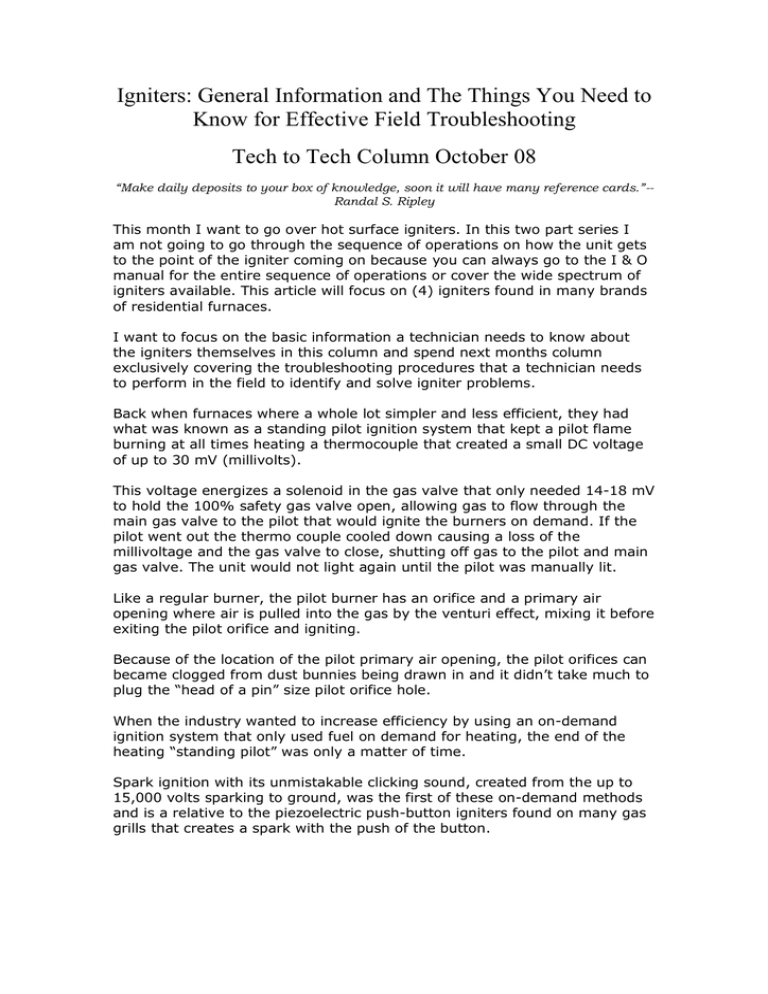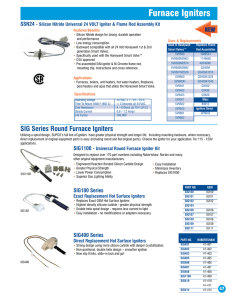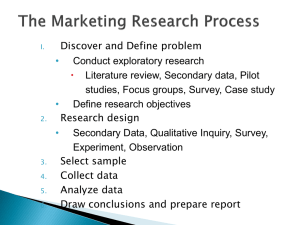Igniters General Information And The Things You Ne
advertisement

Igniters: General Information and The Things You Need to Know for Effective Field Troubleshooting Tech to Tech Column October 08 “Make daily deposits to your box of knowledge, soon it will have many reference cards.”-Randal S. Ripley This month I want to go over hot surface igniters. In this two part series I am not going to go through the sequence of operations on how the unit gets to the point of the igniter coming on because you can always go to the I & O manual for the entire sequence of operations or cover the wide spectrum of igniters available. This article will focus on (4) igniters found in many brands of residential furnaces. I want to focus on the basic information a technician needs to know about the igniters themselves in this column and spend next months column exclusively covering the troubleshooting procedures that a technician needs to perform in the field to identify and solve igniter problems. Back when furnaces where a whole lot simpler and less efficient, they had what was known as a standing pilot ignition system that kept a pilot flame burning at all times heating a thermocouple that created a small DC voltage of up to 30 mV (millivolts). This voltage energizes a solenoid in the gas valve that only needed 14-18 mV to hold the 100% safety gas valve open, allowing gas to flow through the main gas valve to the pilot that would ignite the burners on demand. If the pilot went out the thermo couple cooled down causing a loss of the millivoltage and the gas valve to close, shutting off gas to the pilot and main gas valve. The unit would not light again until the pilot was manually lit. Like a regular burner, the pilot burner has an orifice and a primary air opening where air is pulled into the gas by the venturi effect, mixing it before exiting the pilot orifice and igniting. Because of the location of the pilot primary air opening, the pilot orifices can became clogged from dust bunnies being drawn in and it didn’t take much to plug the “head of a pin” size pilot orifice hole. When the industry wanted to increase efficiency by using an on-demand ignition system that only used fuel on demand for heating, the end of the heating “standing pilot” was only a matter of time. Spark ignition with its unmistakable clicking sound, created from the up to 15,000 volts sparking to ground, was the first of these on-demand methods and is a relative to the piezoelectric push-button igniters found on many gas grills that creates a spark with the push of the button. Spark ignition ignites a pilot on a heating demand and the pilot ignites the burners. When the unit cycle is over the valve closes completely and both the pilot and main burner are extinguished. Another step forward in the on-demand ignition process was “hot surface ignition”; you may hear it called “direct ignition” by some. This method that ignites the gas with a coil that glows white hot and reaches surface temperatures from 1800oF to 31000F is usually placed in line of the gas flow coming from the in-shot burner that it is placed in front of, directly igniting the burner without using a pilot. Even though a large majority of hot surface ignition systems light the main burners directly and do not use a pilot, you may very well run into a hot surface ignition system that ignites a pilot that in turn ignites the main burners. Three styles of heating silicon carbide igniters that will be referenced here are the model 201 with a 34 sec. warm up time and the model 271 with a 17 sec warm time and the model 601 mini-igniter that can reach 1800OF in 5seconds @ 120 volts. Both the 201 & 271 igniters have a minimum temperature of 1800OF at 102 volts, an average temperature of 2400—2600OF at 120 and a maximum of 3100OF at 132 volts and will draw between 3.5—5.0 amps maximum at 132 volts. A 17 second igniter can be used on a 34 second system but not the reverse, given all other factors are equal. The 601 mini-igniter will reach minimum temperature of 1800OF at 102 volts, an average temperature of 2102 to 2650OF at the nominal voltage of 120 volts and its maximum temperature of 2875OF at 132 volts and will draw 0.40 to 1.20 amps at nominal voltage. As you can see even at their minimum voltages these igniters are more than hot enough to ignite propane (920-1020OF) or natural gas (1200OF) that is within the Lower Flammability Limit to Upper Flammability Limit of a gas in air mixture of 2.4%-9.6% for propane and 4%-14% for natural gas. All of these igniters should to be handled gently and only by the ceramic holder because of the fragility of the element, not the “you can’t touch” the igniter myth. In fact many dispute that claim. While doing some research trying to find where this decree that “you cannot touch the silicon carbide element” came from, I found this post on HVACTalk.com from a guy named dorrmann, “I took a White-Rodgers class the other day and the instructor said that it’s basically an old wives tale. He rubbed it on his forehead (to get a LOT of oil), then fired it up. It worked just fine.” Dorrmann did however unequivocally state he would not be making a habit of doing this and would continue to handle them by the ceramic holder. This is the opening paragraph in the © 1997 copy of “Hot Surface Ignition Systems” by the Gas Appliance Service Training Center, “The silicon carbide element can be handled without damage; however it is better and safer to handle the igniter by the ceramic holder. The myth that the silicone carbide tip can not be handled because body oils cause contamination is untrue.” Silicone carbide igniters have had issues over the years of needing to be replaced often before their manufactured life time of 100,000 cycles for house hold appliances because of the thermal cycling of the igniter causing the ceramic element to become more brittle. Thermal cycling can lead to the igniter not reaching appropriate ignition temperatures, burnout, cracking and/or breaking. To battle this problem manufacturers developed controls with adaptive ignition control that monitors the ignition cycle and continues to lower the igniters on time until the unit fails to light and then will set the igniter “on time” to the last time the unit fired, holding this time for a given number of cycles before it will adapt itself again. Note: turning the power off to the unit will cause the adaptive control to reboot and the control will have to go through it’s adapt cycle again. Another big development was the “silicon nitride” hot surface igniter that is extremely durable and is very energy efficient using less than half the energy to power them than the 201 or 271 but its on par with the 601 mini-igniters energy usage. The SSN2000 silicon nitride (SiNi) igniter has a warm up time of 17-seconds @ 120 volts with a steady temperature of 2156OF—2426OF. The steady current draw is 1.3 amps (+/- 0.3 amps @120 volts) and its cold resistance is 15-30 ohms @ 77OF. Like the other igniters it is also designed to last for 100,000 cycles. There are some brands of furnaces that use an 80 volt version of the silicon nitride igniter so always check the service manual or I&O manual to ascertain what the voltage is if there is any doubt. These igniters are not interchangeable with silicon carbide igniters but there are universal silicon nitride conversion kits that can be used to convert the ignition system of many units. Some of these kits are capable of replacing 100 different types of silicon carbide igniters. Have a safe & fun Halloween! Randal




